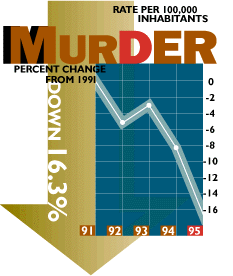

So if police tactics and new laws aren't the primary cause, what is behind the crime plunge? All three professors say it is a numbers game. The population of young people most prone to crime went down in the early 1990s, and the crime rate followed this drop.
"Crime is a phenomenon of the young," declares Weis. In 1980 there were more than 20 million people between 15 and 19 years old. By 1990 that population group had dropped to 17.5 million and reached its low point in 1992 at 17.1 million. Similar drops can be seen in the 20-24 age group, another cohort with a high "crime potential."
It is a wave criminologists have seen before, particularly during and after the baby boomers reached their teen years in the '60s and '70s. Some criminologists, such as James Fox of Northeastern University, even predicted a slight decline in the crime rate would happen in the middle of the 1990s.
But the intensity of the decline has caught most criminologists off guard. Weis, who 10 years ago wrote a paper with a graduate student trying to chart crime rates into the 21st century, predicted a gradual increase--which may still happen, he warns.
And if demographics is the key, why hasn't the rate gone back up along with the rise in the 15-19 age group, which has been growing over the last two years and now stands at about 18.5 million?
"There is usually a time lag," says Weis. "It is going to take awhile until you see a critical mass."
 In addition to the
numbers in a particular age group, Weis sees two other factors in how
demographics affect the crime rate. He feels there is a "cohort" effect when an
age group reaches a "critical mass," such as in the late '60s when the crime
rate soared as baby boomers reached their late teen years.
In addition to the
numbers in a particular age group, Weis sees two other factors in how
demographics affect the crime rate. He feels there is a "cohort" effect when an
age group reaches a "critical mass," such as in the late '60s when the crime
rate soared as baby boomers reached their late teen years.
Unknown historical factors can also influence crime-prone age groups. Weis says the "period effect" of the Vietnam War in the '60s and of crack cocaine in the '80s helped push up the crime rate in those decades.
But Bridges warns that demographics can't explain everything. "We don't have the theories or evidence to make those predictions. It's not like physics. Human behavior at the aggregate level is very hard to explain."
All three criminologists concede there is more than just population statistics going on, but they diverge slightly when they examine the other factors that may be contributing to the drop in crime.
If police work is not the answer, could it be changes in criminal behavior itself? Several sociologists see a drop in the use of crack cocaine and an easing of "turf wars" between gangs to control the crack market.
There may be something to this theory, says Weis. Crack reinvigorated the gang scene in the 1980s. "It made a social and economic context where gangs could flourish," he explains, similar to the rise of organized crime during Prohibition in the 1920s. A turn away from crack could contribute to peace on the streets.
But Bridges doubts the drop in gang activity could account for the overall plunge in crime. "I'm not persuaded that gangs are responsible for all the activities that are attributed to them, particularly in the city of Seattle," he says.
"Crack and gangs were kind of a bogeyman," adds Crutchfield. "Even at the height of gang paranoia, there were very few gang murders for the amount of coverage they got in the press."
Tougher Penalties--Even Death Sentences--Don't Make a
Difference, Say Profs
It's the Economy,
Stupid--Isn't it?
Send a letter to the editor at columns@u.washington.edu.